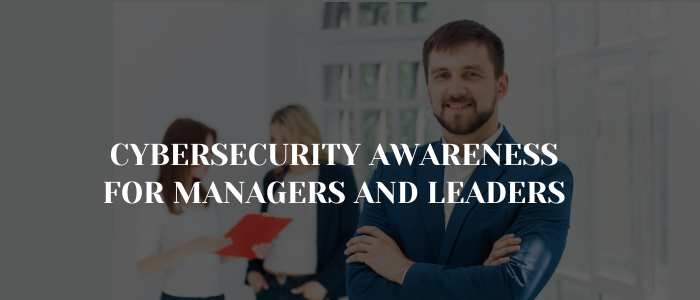
Cybersecurity Awareness for Managers and Leaders: How to Create a Culture of Security
- Samruddhi Jadhav
- 0
- on Oct 23, 2023
Technology is deeply integrated into businesses in this interconnected world, and the significance of cybersecurity awareness cannot be emphasized enough. Managers and leaders hold a critical responsibility in recognizing the significance of cybersecurity and taking proactive measures to cultivate a culture of security within their organizations.
Rapid technological advancements have brought about numerous benefits and opportunities for businesses. However, they have also opened the doors to various cybersecurity threats. Organizations, regardless of size or industry, are vulnerable to cyberattacks, which can disrupt operations, damage reputations, and cause financial loss.
Cyber threats have evolved and become more sophisticated over time. Attackers are constantly finding new ways to exploit vulnerabilities in networks, systems, and human behavior. Organizations today encounter prevalent cybersecurity threats, including malware, phishing attacks, ransomware, and social engineering. Each of these threats represents a unique risk and can cause significant damage if not properly addressed.
Understanding the potential impact of cyber attacks on business operations, reputation, and finances is essential for managers and leaders. Successful cyberattacks can result in data breaches, service interruptions, economic losses, regulatory penalties, and loss of customer confidence. By comprehending the potential consequences, managers and leaders can grasp the urgency of prioritizing cybersecurity awareness within their organizations. In this blog, we will discuss more on Cybersecurity awareness for Managers and Leaders.
Understanding Cybersecurity Threats
Organizations face a myriad of cybersecurity threats that can have severe consequences if addressed. Understanding these threats is essential for managers and leaders in order to effectively protect their organizations.
Malware Malware is malicious software intended to infiltrate a computer system or network and cause damage or unauthorized access. Viruses, worms, ransomware, spyware, etc. Malware attacks can lead to data breaches, financial losses, and business disruption
Phishing attack A phishing attack is a deceptive attempt to obtain sensitive information such as usernames, passwords, and credit card details by impersonating a trusted individual. These attacks are often carried out through deceptive emails, messages, or websites. Being a victim of a phishing attack can lead to privacy breaches and unauthorized access to sensitive information.
Social Engineering Social engineering is a tactic used by cybercriminals to manipulate individuals into revealing sensitive information or taking actions that compromise security. This can include impersonating a trusted colleague, controlling emotions, or exploiting human vulnerabilities. Social engineering attacks can lead to data breaches and unauthorized access to critical systems.
Ransomware Ransomware is a type of malicious computer program that encrypts a victim’s records and demands a ransom in exchange for reestablishing access. It can cause significant disruption to business operations and financial loss if organizations are unable to recover their data.
Insider Threats Insider threats refer to security risks that individuals within the organization pose. These threats can be intentional or unintentional and may include employees, contractors, or business partners. Insider threats can result in data breaches, intellectual property theft, or sabotage.
By familiarizing themselves with these cybersecurity threats, managers and leaders can better understand the potential risks faced by their organizations. This understanding serves as a foundation for developing robust security measures and fostering a culture of security.
Creating a Culture of Security
Managers and leaders play a crucial role in establishing a culture of security within their organizations. By actively promoting cybersecurity awareness, you can influence your team members to make security a priority in their day-to-day activities. Setting a tone of cybersecurity awareness at the top is vital to the success of this endeavor.
One of the most effective ways to create a culture of security is by demonstrating your commitment to cybersecurity. Allocate adequate resources for security measures, such as investing in robust security technologies, conducting regular security audits, and employing dedicated cybersecurity professionals. Managers and leaders can instill confidence and encourage employees to follow suit by visibly supporting security initiatives.
Open communication and discussion about cybersecurity risks and their potential impact is another crucial aspect of creating a culture of security. Encourage employees to voice their concerns and report potential incidents or vulnerabilities without fear of retribution. This transparency fosters an environment where everyone takes responsibility for their role in maintaining security.
Leading by example is also essential for establishing a culture of security. Managers and leaders should adhere to security policies and procedures themselves and actively engage in safe practices. This includes using strong passwords, following proper data handling procedures, and staying informed about the latest security trends. When employees see their leaders prioritizing security, they are more likely to do the same.
Developing Security Policies and Procedures
Establishing comprehensive security policies and procedures is a fundamental step in creating a culture of security. These guidelines provide employees with clear expectations and guidelines to follow, ensuring consistent and secure practices throughout the organization.
Start by conducting a thorough assessment of your organization’s cybersecurity needs and risks. This assessment will help you identify the areas that require specific policies and procedures. Some key areas to consider include; password management, data handling and classification, access controls, incident response, and the acceptable use of technology resources.
When developing security policies, involve key stakeholders from different departments, such as IT, legal, and HR. This collaboration ensures that policies align with legal requirements, industry best practices, and the organization’s unique needs. Regularly review and update these policies to address emerging threats and technological advancements.
Ensure that security policies are easily accessible to all employees. They should be written in clear and concise language, avoiding technical jargon whenever possible. Provide training or orientation sessions to ensure that employees understand the policies and their responsibilities in adhering to them.
To further reinforce adherence to these policies, consider implementing technologies and controls that support secure practices. This may include multifactor authentication, data encryption, regular system patching, and intrusion.
Detection systems. By integrating these security measures into the organization’s infrastructure, managers and leaders can demonstrate a commitment to protecting sensitive data and mitigating risks.
Cybersecurity Awareness Education & Training for Managers and Leaders

Creating a security culture requires educating and training employees on cybersecurity best practices. Many successful cyber-attacks are a result of human error or lack of awareness. By investing in regular training sessions, managers and leaders can equip employees with the knowledge and skills needed to identify and mitigate potential threats.
Develop a comprehensive training program that covers various topics, such as recognizing phishing techniques, safe browsing habits, secure password practices, and incident reporting procedures. Consider utilizing interactive training methods, such as simulations and role-playing exercises, to make the learning experience engaging and practical.
Encourage a culture of continuous learning by providing ongoing awareness campaigns, newsletters, and workshops. Regularly communicate updates on emerging threats, new security policies, and best practices to keep employees informed and vigilant. Foster an environment where employees feel comfortable asking questions and seeking clarification regarding cybersecurity matters.
Furthermore, fostering an environment of open communication is vital. Encourage employees to report potential security incidents or concerns without fear of repercussions. Establish channels to facilitate the reporting process, such as dedicated email addresses or anonymous reporting mechanisms. By actively listening and responding to employee concerns, managers and leaders can demonstrate their commitment to maintaining a secure work environment.
In conclusion, cybersecurity awareness is a critical aspect of modern business operations. Managers and leaders are responsible for creating a culture of security within their organizations. By understanding cybersecurity threats, setting a tone of cybersecurity awareness at the top, developing robust security policies and procedures, and providing comprehensive employee education and training, organizations can strengthen their defenses against cyber attacks.
Remember, cybersecurity is not a one-time effort but rather a continuous process that requires proactive measures and collective commitment from everyone in the organization. By fostering a culture of security, organizations can mitigate risks, protect sensitive data, and ensure a secure digital environment for their businesses.
As a manager or leader, you have the power to influence and shape the security mindset of your team. Embrace the challenge, lead by example, and invest in the necessary resources to create a resilient cybersecurity posture. Together, we can navigate the evolving cyber landscape and safeguard our organizations against the ever-present threat of cyber attacks.